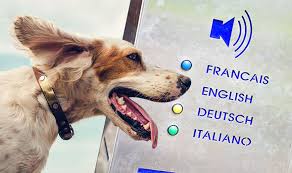A Device That Translates Woofs and Meows Into Words (Not Sci-Fi!)
Dr. Con Slobodchikoff, Pet Translators
 Dr. Con Slobodchikoff (Professor Emeritus NAU) believes we are close to developing a gadget that will translate what your dog or cat is saying into English words. While several novelty items are currently on the market, his work is based in science. Slobodchikoff says, "So many people would dearly love to talk with their dog. With cats, I'm not sure what they'd have to say. A lot of times it might just be, "You idiot, just feed me.'"
Dr. Con Slobodchikoff (Professor Emeritus NAU) believes we are close to developing a gadget that will translate what your dog or cat is saying into English words. While several novelty items are currently on the market, his work is based in science. Slobodchikoff says, "So many people would dearly love to talk with their dog. With cats, I'm not sure what they'd have to say. A lot of times it might just be, "You idiot, just feed me.'"
So how accurate will it be? Dr. Slobodchikoff explains that they're using science to do this and so it should be really accurate. It should tell you what the dog is thinking, what the dog's emotions are like and what the dog wants to do.
This seems kind of far-fetched, because men and women who both speak English have a hard time understanding one another. How is it going to be possible that we really get a grasp of what our animals are saying?
Dr. Slobodchikoff explains that body language is a big component of people understanding what other people are saying. In fact, some studies have shown that in a conversation between two people, 90-percent of the meaning is conveyed by body language and only about 10-percent is conveyed by what they say. So if the man says something like, "I love you" and the body language says something like, "I really hate to be here right now!" What do you think the other person is going to pick up on the, "I love you" or "I really hate to be here right now!" They'll obviously pick up on the, "I hate to be here right now!" Maybe not necessarily consciously, but they'll think that person doesn't mean it when they say, " I love you."
So body language is a really big component of communication of people and it turns out to be a big component in communication of animals as well. What scientists are doing is looking at both the body language of dogs and the vocalizations of dogs and then using artificial intelligence to combine those two to come up with an accurate reading of what the dog is trying to communicate.
Dr. Debbie thinks that this idea sounds fabulous and wonderful, but she's just thinking of all those variables when a dog has something medically going on. Are they going to be able to speak to us and tell us what's wrong? Would they understand what's wrong? Would they be able to describe pain? For instance, could they tell us things like describe my abdomen hurts versus what a person could conceptualize and put it into words?
 Dr. Slobodchikoff explains that there's a study using artificial intelligence to figure out a sheep's pain from their facial expressions. The other thing is that there's a person who has been teaching dogs to communicate by pointing to various parts of their body. This woman has found really remarkable success once she's taught the dogs this kind of pointing language, the dogs can then actually point to areas that hurt. When she then takes them to the vet, the vet confirms that there are problems with the areas that the dog has pointed to.
Dr. Slobodchikoff explains that there's a study using artificial intelligence to figure out a sheep's pain from their facial expressions. The other thing is that there's a person who has been teaching dogs to communicate by pointing to various parts of their body. This woman has found really remarkable success once she's taught the dogs this kind of pointing language, the dogs can then actually point to areas that hurt. When she then takes them to the vet, the vet confirms that there are problems with the areas that the dog has pointed to.
So we know that dogs can actually do that and we know that artificial intelligence can actually read things like pain signals and other kinds of expressions.
So will it be harder to communicate with cats? Dr. Slobodchikoff tells us that cats also have a rich body language and they also have vocalizations. One study found the cats had somewhere over a 120 different kinds of vocalizations. So he thinks that it would be just as feasible to do that with cats. However, do you really want to know what your cat is thinking?
So if they are developing a translator that helps people understand what our dogs are trying to communicate, is there a reverse translator so our dogs can understand what we are trying to communicate to them?
That would be ideal, according to Dr. Slobodchikoff, but that's a slightly harder problem than the one -way sort of thing. However, it may not be as much of a problem as he currently thinks it is, because a lot of dogs actually already understand what you're saying to them. For example, there was a dog named Chaser, who knew upwards of about a 1,000 words in English. There was also a dog named Rico who knew upwards of 300 words in German. So dogs actually know a lot of what we're saying to them but we people are really bad at figuring out what dogs are trying to say to us.
In an age where you have the iPad tablets or the iWatches that you talk into like Dick Tracy, maybe pet translators could really happen in the near future!
Visit Website
It's Not Doggie Asthma - It's a Reverse Sneeze - Dr. Debbie
 What dog owner hasn't heard that frightening sound that dogs make - part cough, part sneeze and often described as a dog being unable to catch his breath. But it really isn't asthma, or some kind of bone stuck in your dog's throat - it's a reverse sneeze. So before you panic and run into the veterinary office on emergency, ensure you know what a reverse sneeze is.
What dog owner hasn't heard that frightening sound that dogs make - part cough, part sneeze and often described as a dog being unable to catch his breath. But it really isn't asthma, or some kind of bone stuck in your dog's throat - it's a reverse sneeze. So before you panic and run into the veterinary office on emergency, ensure you know what a reverse sneeze is.
Meet the Reverse Sneeze
A reverse sneeze is a respiratory sound in a category all its own. Also known as a pharyngeal gag reflex or backwards sneeze, the reverse sneeze is a commonly observed respiratory sound in dogs, and less commonly in cats. While a true sneeze occurs on the exhale, the reverse sneeze occurs as the dog inhales. The result is a reverberating snorting, wheezing, episodic sound that lasts for a few seconds to a minute or two. A reverse sneeze is a completely harmless sound and dogs do not suffer any immediate health threat from these episodes.
How can you tell it's a reverse sneeze?
There is no easy explanation of the sound - you just have to hear it and you'll recognize it. Click to see and hear an example of a dog's reverse sneeze episode.
Part of my enjoyment on the weekly national radio program, Animal Radio, is describing the peculiar smells, sounds and essences of veterinary medicine with our listeners. On many an occasion when speaking to callers, I have re-created the sounds of reverse sneezing. I'm no Rich Little, but I do take pride in my impersonation of a canine reverse sneeze, which is admittedly better in person with the visuals to complement the throaty sound.
Characteristics of a dog displaying a reverse sneeze include:
- Vibrational coughing/wheezing sound
- Stiff, extended neck
- Facial grimace
- No discharge from nose
- Not followed by coughing or vomiting up material
- Not involving collapse episodes
- Animal is completely normal after event
What causes a reverse sneeze?
Some reverse sneeze episodes occur when a dog gets very excited or pulls against a leash. Brachycephalic breeds (short faced breeds) like Pugs and Boston terriers commonly display reverse sneezing due to their upper airway conformation.
 Allergies, respiratory infections, nasal mites, inhaled foreign bodies and masses can also trigger reverse sneezing. Dogs with inflammatory conditions such as lymphoplasmacytic rhinitis can also display bouts of reverse sneezing. And sometimes reverse sneezing occurs in the wee hours of the night, while a dog is sleeping, for no apparent reason. In fact, many veterinarians receive panicked phone calls at 2am from pet owners, concerned of impending asthma attacks or respiratory arrest, only to have it turn out just to be a typical case of reverse sneezing.
Allergies, respiratory infections, nasal mites, inhaled foreign bodies and masses can also trigger reverse sneezing. Dogs with inflammatory conditions such as lymphoplasmacytic rhinitis can also display bouts of reverse sneezing. And sometimes reverse sneezing occurs in the wee hours of the night, while a dog is sleeping, for no apparent reason. In fact, many veterinarians receive panicked phone calls at 2am from pet owners, concerned of impending asthma attacks or respiratory arrest, only to have it turn out just to be a typical case of reverse sneezing.
What to Do?
There is no required treatment for a reverse sneeze episode. However, I recommend stroking a dog's throat while gently speaking to him in a calm manner until the episode subsides. Some advocate closing/pinching the nostrils off, which forces a dog to swallow and curtails the reverse sneeze episode. Whatever the approach, reverse sneezing episodes are over within minutes, so no emergency treatment is indicated. Antihistamines may be prescribed to minimize reverse sneezing episodes.
When to Worry?
If all of a sudden your dog is having repeated bouts of reverse sneezing, evaluation by your veterinarian is indicated. Consult with your veterinarian if your dog is reverse sneezing along with other symptoms such as facial rubbing, nasal bleeding, nasal discharge, coughing, or significant sneezing episodes.
Nasal mites are a common cause of reverse sneezing and may be noted after a recent boarding visit, especially if multiple dogs in a household are involved. Nasal mite treatment is easily pursued with anti-parasite injections of ivermectin (or in collie breeds - the alternative Milbemycin.) If reverse sneezing is excessive and prolonged, the nasal and pharyngeal areas should be evaluated by a veterinarian through rhinoscopy - a procedure performed under anesthesia in which the nasal passages and pharyngeal areas are visualized with an endoscope, a micro camera. This is how foreign objects and masses are typically identified. In other cases, further tests may be needed including a CT scan or with biopsy samples from sinus passages.
Final Thought
The good news is that most of reverse sneezing episodes are harmless, and do not indicate any serious illness. Arm yourself with information by learning what a reverse sneeze looks like and you may save yourself an unwanted emergency veterinary visit over this peculiar but non-life threatening occurrence.
Featured veterinarian known as "Dr. Debbie" on national pet radio program, Animal Radio. Ebook author of "Yorkshire Terriers: How to Be Your Dog's Best Friend"; "Pugs: How to Be Your Dog's Best Friend"; "Mini Schnauzers: How to Be Your Dog's Best Friend"; and "Shih Tzu: How to Be Your Dog's Best Friend." Dr. Debbie's books.
Visit Website
 The Dogfather's Grooming Tip with Joey Villani
The Dogfather's Grooming Tip with Joey Villani
Removing Stains From Your Dog
Have you ever been to the Grand Canyon? If you haven't, the Grand Canyon has a lot of red clay. You track it everywhere and stains like crazy. It stains your clothes, your carpet and even your animal.
Not surprisingly, Joey had someone who contacted him after returning from the Grand Canyon. It turns out their white West Highland Terrier brought back some of this staining red clay on their coat. Joey's remedy to dealing with this only works on light colored dogs and will turn a black dog's coat with a reddish tint. But fortunately, this red clay doesn't show up very well on dark colored dogs anyway.
For Joey's remedy, you take an eighth of a cup of hydrogen peroxide and mix it with a eighth of a cup of corn starch, making a paste. If it's a little too soupy, just add more corn starch because you want something that has a thick consistency, almost a little bit less than the paste you used to use in grammar school. Next, you put this mixture on the areas where the dog is stained. You then let it sit there for a good 20 to 30 minutes. After that, just brush it off and the stain should be gone completely.
If your dog does decided to lick it, the corn starch is nontoxic and the peroxide is not going to hurt them. However, you could have some intestinal gas issues afterwards.
Joey says to never use baking soda in place of the cornstarch because this can make your dog sick and maybe even irritate their skin, so corn starch actually works better.
Animal Radio News - Lori Brooks
 Pets On Planes
Pets On Planes
Maybe it was better that Dexter the Peacock didn't get on the plane a few years ago, because a bulldog named Bator was allowed on a flight and was discovered dead in his flight carrier after the plane landed at Newark airport. In another case, an American bulldog named Hope on board a United Flight from Santo Domingo was also found dead when his plane landed at Newark. And Rock, a 3-year-old Belgian Malinois who was flown to Newark aboard a flight from Boston, was discovered with multiple bruises after escaping from his plastic shipping container during the flight. There was also a cat named Gage who escaped its kennel at Honolulu International Airport before being loaded aboard an Alaska Airlines flight and was never seen again. The deaths and injuries were only a small percentage of the animals transported by 17 airlines. This, of course, comes as an increasing number of pet parents are attempting to take their dogs and cats (and peacocks) on board, claiming them to be service animals. The biggest air carrier at Newark, United Airlines, accounted for most of the deaths and injuries nationwide. A spokesman for the company said United saw a significant increase in the number of pets it transported last year, which may have accounted for the rise in transported pet deaths. According to the federal data compiled by the DOT's Aviation Consumer Protection Division, most of the injuries were self-inflicted, caused by an animal's chewing or clawing at their transport crates. However, the Animal Legal Defense Fund has questioned the accuracy of the Federal data, and says people should be skeptical because the Department of Transportation does not require airlines to report deaths or injuries for non-companion animals except for cats and dogs. That means animals being shipped to zoos or research facilities are not reported in the statistics. One crate training exercise recommended to owners to help their pets with flying is to put the pet in its shipping carrier and drive through the car wash a few times, so that the noise, vibration and movement in the plane does not cause alarm. Another option may be to save the money you would use to put your pet on an airplane and instead book a reliable pet sitter. You might even save some money.
 Counting Cats
Counting Cats
Because most everyone has their own opinion on whether cats or dogs are smarter, a study created quite a stir when it suggested that dogs might have an intelligence edge over cats. On the other hand, a few other studies have shown that cats have a greater mathematical ability than dogs. Meanwhile, other less traditionally "smart" animals like fish and frogs, are able to count. In addition, so can chickens and some monkeys, although scientists say research on cats being able to count is unclear at this point. That's mostly due to the fact that cats are difficult to control in a lab environment. So, can cats count? As with most things, the answer might be only if they feel like it. One researcher at the University of Padova in Italy who studied cat cognition said most cats were excluded from research because it's simply easier to work with fish than cats. However, he did a counting study with cats, which was basically the ability to distinguish small quantities from large ones. When the cats did decide to cooperate, they were as good at the mathematical tests as fish, but often the cats just walked away. So now he remains unconvinced that cats can't count and thinks we should keep studying them. Researchers also suspect cats may have an abstract conception of numbers, but it has been suggested that cats may be able to count up to six or seven, though three or four is more likely.
Dating Advice For Pet Parents
For pet parents, things can get complicated if you are in a relationship that progresses to the point where you are thinking about moving in together. And if the other person is also bringing a pet to the new household then you have a lot to consider. An article in Parade Magazine offered some good advice to pet parents who want to combine households had some interesting tips. If you're using dating apps to find a mate, include your pet in your online dating profile so prospects know upfront that your pet is a priority. When you get to the point that you want to introduce him or her to your pet, remember to stay calm because your body language could confuse a fur child with a stranger in their presence, especially if you're on their home turf. Because of that, experts agree your first meet-and-greet should be on neutral ground like at a dog park or other pet friendly location. If that won't work for you, walk your dog out to meet the visitor and then walk back inside your home or apartment together. You may have to do this a few times when your partner visits, but letting your pet dog or cat make this first move to check out the person is critical. Don't force it. In the case of cats, ignoring a cat can work too. Just let your cat make the first move to check out the new human. Another great tip is to have the new human leave behind an article of clothing like a sock or a t-shirt, then give your dog or cat a treat every time they sniff it. Positive association with scent goes a long way.
 Listen to the entire Podcast of this show (#1160)
Listen to the entire Podcast of this show (#1160)





